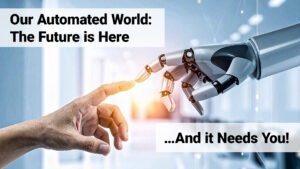
Our Automated World: The Future is Here (… And it Needs You!)
Our Automated World: The Future is Here (… And it Needs You!) AI and automation are no longer creeping into manufacturing—they’ve arrived, settled in, and
2025 is finally here and, in the months ahead, the manufacturing landscape is likely to undergo a profound transformation, shaped by a rapid acceleration of – what else — digital technologies.
The convergence of emerging tools like artificial intelligence (AI), the Internet of Things (IoT), robotics, additive manufacturing, and augmented reality (AR) promises to not just enhance productivity but also redefine the very nature of how goods are produced, distributed, and consumed.
As digital transformation continues to unfold, manufacturing companies will find themselves at a crossroads—those who embrace these technologies could lead the way in efficiency and innovation, while those who hesitate may struggle to remain competitive.
Today, we look at what this new year could have in store for manufacturers based on past and current industry trends and what it all could mean for, not just you, but the entirety of the manufacturing industry.
Is 2025 the year of the smart factory?
If recent trends continue on their current path, smart factories powered by interconnected systems of IoT devices and AI-driven analytics may very well become the industry standard by the end of the year.
In this situation, these factories will likely be populated by machines capable of communicating with one another in real time, autonomously adjusting processes based on predictive insights.
The integration of AI into production lines could enable manufacturers to anticipate and address issues before they even arise, possibly reducing downtime and improving operational efficiency.
In addition, predictive maintenance, real-time monitoring of production, and adaptive scheduling could become commonplace, giving businesses the agility needed to stay competitive and leaving those who have yet to take the initial steps into Industry 4.0 that much further behind.
As robotics technology evolves, it’s anticipated that collaborative robots (cobots) will be an essential part of most manufacturing environments.
This is just as true in 2025 as it was in years prior.
In 2025, these robots may work alongside human employees to carry out repetitive, dangerous, or precision tasks, driving higher productivity and safety.
… And while automation could lead to job displacement in certain areas, it’s likely that new roles will emerge for workers with specialized skills in AI programming, robotics maintenance, and digital systems management.
As such, manufacturing companies will need to invest heavily in reskilling their workforce to keep pace with these technological shifts.
Additive manufacturing, more commonly known as 3D printing, is predicted to become a game-changer in the coming years.
By the end of 2025, its potential for producing highly customized and complex parts on demand could become an integral part of production strategies.
Manufacturers in industries such as aerospace, automotive, and healthcare are expected to increasingly leverage this technology to produce lighter, more durable, and personalized components.
The ability to rapidly prototype and produce parts could dramatically reduce supply chain bottlenecks, eliminate inventory concerns, and drive cost savings.
As the technology improves, the widespread adoption of 3D printing might pave the way for decentralized, on-demand production facilities.
With environmental concerns rising among both consumers and regulators, it’s likely that sustainability will become a central priority for more manufacturers in 2025.
Current eco friendly practices such as circular manufacturing, which focuses on reducing waste and reusing materials, could gain significant traction in the months ahead.
Manufacturers may even start to adopt AI-driven systems to optimize production processes for minimal resource consumption, monitor energy usage, and maximize the reuse of materials.
The ability to recycle products at the end of their lifecycle could become increasingly automated, making it easier for businesses to comply with environmental regulations and meet consumer demand for greener products and renewable energy sources like solar or wind could also become more integrated into manufacturing operations, potentially lowering carbon footprints and improving overall sustainability.
By 2025, the concept of digital twins—a topic we previously covered HERE—could become commonplace in the manufacturing sector.
These virtual models could simulate everything from individual parts to entire production facilities, providing manufacturers with the ability to experiment and test in a risk-free environment.
Using digital twins, companies might optimize designs and processes, troubleshoot issues, and reduce costly trial-and-error in physical production.
Predictive analytics through digital twins could also enable manufacturers to anticipate maintenance needs and reduce downtime, resulting in smoother and more efficient operations.
As 5G technology becomes more widespread, it’s expected to play a pivotal role in transforming the manufacturing industry.
The increased speed and lower latency of 5G could allow for the seamless transmission of data from IoT devices, sensors, and machines on the factory floor.
This enhanced connectivity could make real-time monitoring and remote management of production processes a reality.
Additionally, edge computing—where data is processed closer to the source rather than in distant cloud data centers—could further reduce response times and improve efficiency.
With 5G and edge computing, manufacturers might have the ability to make faster, data-driven decisions on the fly, enabling them to respond quickly to market demands and production challenges.
Finally, we come to the hot-button topic of cybersecurity.
As the digital transformation of manufacturing accelerates, so too will the need for robust cybersecurity systems.
This year, manufacturers will likely face an increased risk of cyberattacks targeting their interconnected systems, machines, and supply chains.
With the rise of IoT devices and AI-driven systems, securing sensitive data and safeguarding operational technologies could become top priorities.
To help combat such lingering threats, manufacturers are expected to invest more heavily in AI-powered cybersecurity solutions that can detect and mitigate threats in real-time, protecting both intellectual property and the integrity of production lines.
Folks, 2025 is poised to usher in a new era for manufacturing, one where digital technologies redefine the industry’s capabilities and competitiveness.
From smart factories and automated production lines to sustainable practices and personalized products, the potential for digital transformation is vast.
However, this future will not be realized equally by all.
Companies that are willing to embrace change—by investing in new technologies, reskilling their workforce, and prioritizing sustainability—are likely to lead the charge in this new industrial revolution.
… Those that resist or fail to adapt to these rapid changes may find themselves outpaced by competitors that have harnessed the power of digital tools.
And while the precise trajectory of manufacturing in 2025 remains uncertain, one thing is clear: the digital transformation of the industry will likely be one of the defining stories of the coming decade.
The question for manufacturers will not be whether they can survive this transformation, but whether they can thrive in it.
P.S. As you can see, 2025 is sure to be a transformative year for the manufacturing industry.
If you want to be a part of it and have yet to jump on board the Industry 4.0 band wagon, NOW is the time to take action.
Folks, as we venture further and further into the 21st century, there is less and less doubt that the way of the future for the manufacturing industry is digital.
… And – in our competitive landscape – if you are unable to speak the digital language, you will simply be passed over for someone who can. It’s as simple as that.
Want to be an integral part of the future of this industry?
Industry 4.0 is the answer.
… And if you need help with Industry 4.0, Rain Engineering is your answer.

Our Automated World: The Future is Here (… And it Needs You!) AI and automation are no longer creeping into manufacturing—they’ve arrived, settled in, and

Rare Earth Minerals and the Manufacturer’s Dilemma: How Global Politics and Critical Materials are Shaping the Future of American Industry In today’s industrial landscape, manufacturers

Manufacturing’s Quiet Crisis: The Generational Divide That’s Reshaping Industrial Work The manufacturing industry is standing on the edge of a transformation that reaches far beyond

Ready to Explore the Future of Manufacturing? As global markets become more volatile and customer demands shift faster than ever, manufacturers are at a critical

Trade Tensions Reloaded: What the Rising US-China Tariff War Could Mean for Manufacturers If you’re a U.S. manufacturer, you’ve already weathered your fair share of

Industry 4.0: A Win for Your Business and Your Workforce The manufacturing sector has always been the backbone of economies worldwide, but the current landscape
